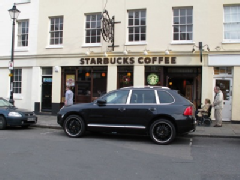England-2011-lab1-orange
Lab Write-up for the Orange Group (Charlie)
- 22 February 2011
- N.B. - I did not collect any data or do any of the work described below, it's purely an example of one way to write-up a lab report. The procedures, error analysis and such are accurate, just the data has been faked.
Overview
Greenwich, England is home to the Prime Meridian, the arbitrary line that signifies 0 degree longitude for global navigation. The lab assignment, Where am I?, asks us to determine where a particular location in Greenwich is located using different tools/methods to determine the latitude, longitude, elevation and distance to the Prime Meridian of that location.
Data Collection
The spot I was assigned was just outside the Starbucks in Greenwich:
The lab instructions specify that we should use three different tools/methods to determine the latitude, longitude and elevation. Listed below are the choices I made:
- Latitude - GPS, Google Earth, and estimation
- Longitude - GPS, Google Earth, and estimation
- Elevation - GPS, Google Earth, and estimation
Next the instructions ask us to determine what is due North and due South of that location:
- North - compass and visual observation
- South - compass and visual observation
Lastly the instructions ask us to determine the distance from that spot to the Prime Meridian using two different tools/methods, I used Google Earth and estimation for this quantity.
Equipment and Procedures
- Garmin etrex handheld consumer GPS unit, software version 3.5.0
- Using the GPS involves powering it on, waiting for it to acquire enough satellite signals, noting the margin of error, and then switching the mode to waypoint which displays the latitude, longitude, and altitude. To obtain three readings I slowly spun in a full circle while chanting "umm" and then stopped and waited for the GPS to produce a new reading.
- Google Earth software, version 6.0.1.2032 (beta), running under OSX 10.6.6
- Once Google Earth is launched you can enter the location of interest in the search box and then zoom-in to the appropriate magnification for the task at hand. To obtain three readings I moved the mouse around on the screen and then returned it to the point of interest and re-read the latitude, longitude and altitude from the status bar on the bottom of the screen.
- Estimation using a 48 year old white male American with a background in science and engineering
- For the latitude I found the nearest lamp post and noted the latitude marked on it.
- For the longitude I found the nearest lamp post and noted the longitude marked on it.
- For the altitude I found the nearest lamp post and noted the altitude marked on it.
- For the distance to the Prime Meridian I calculated my pace by walking the length of the Cutty Sark 3 times, averaging the number of paces, and then dividing the known LOA of 280' <ref>Cutty Sark</ref> by that value. Using this method my pace was determined to be 2.5'. Using the hand-held compass as a guide I walked a line due East from the spot to the Prime Meridian keeping track of the number of paces. I then reversed my direction and walked back to the spot following the same path. I averaged the number of paces from the two trips and then multiplied that value by 2.5' to obtain an estimate of the distance.
- Silva bog standard hand-held compass, circa 1975
- While holding the compass on the outstretched palm of your hand, and using the centering bubble to ensure that it's level, a reasonably accurate reading can be taken if you hold your head directly above the compass and look straight down.
Sources of Error
There are many sources of error, built-in and human, when using navigation instruments such as those employed for this lab. Below is a discussion of those as they apply to each instrument.
- GPS - Each GPS system has built-in error which varies depending on the specific unit, the number of satellites which are "visible" in the sky, and other internal factors. The Garmin unit I used displayed the accuracy of measurements each time it powered-up and acquired satellites. Each time I used it in Greenwich it stated that it had 3m accuracy. Greenwich is also home to the GPS Meridian, the 0 degree longitude for the GPS system. This meridian lies approximately 100m East of the Prime Meridian <ref>Prime Meridian</ref> which can cause confusion when using a GPS to measure the distance from a given location to the Prime Meridian.
- Google Earth -
- Compass
- Estimation
Results
table
Extra Credit: Visualization
Map with circle?
Appendix A: Raw Data
table
References
<references />
A description of the task at hand and your approach to the work. A description of the spot you are working from. The measurements as listed under Details above, for each of the tools/methods, organized in tabular form. A discussion of the sources of error associated with each of the tools/methods you employed and the likely range into which the correct answer is likely to fall for each of them. The raw data, that is each value read (at minimum 3 values for each data point) for each tool/method you employ for a given measurement. Extra Credit: A basic visualization which utilizes an aerial image with a placemark at the spot, labeled with the coordinates, and visual indications of the "zone of error" for each of the tools/methods you employed.
